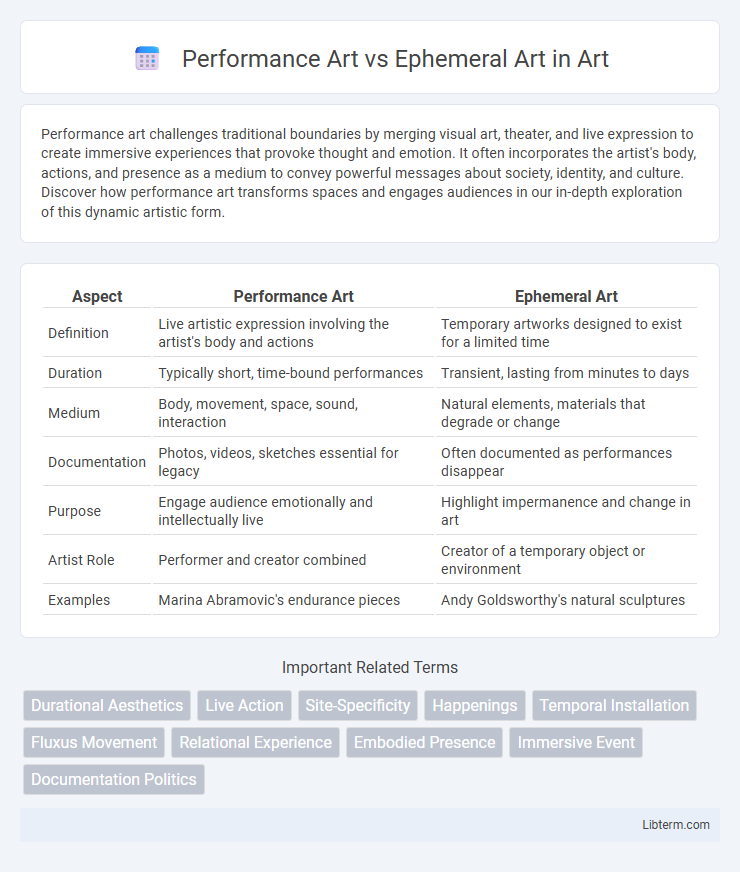Performance art challenges traditional boundaries by merging visual art, theater, and live expression to create immersive experiences that provoke thought and emotion. It often incorporates the artist's body, actions, and presence as a medium to convey powerful messages about society, identity, and culture. Discover how performance art transforms spaces and engages audiences in our in-depth exploration of this dynamic artistic form.
Table of Comparison
| Aspect | Performance Art | Ephemeral Art |
|---|---|---|
| Definition | Live artistic expression involving the artist's body and actions | Temporary artworks designed to exist for a limited time |
| Duration | Typically short, time-bound performances | Transient, lasting from minutes to days |
| Medium | Body, movement, space, sound, interaction | Natural elements, materials that degrade or change |
| Documentation | Photos, videos, sketches essential for legacy | Often documented as performances disappear |
| Purpose | Engage audience emotionally and intellectually live | Highlight impermanence and change in art |
| Artist Role | Performer and creator combined | Creator of a temporary object or environment |
| Examples | Marina Abramovic's endurance pieces | Andy Goldsworthy's natural sculptures |
Introduction to Performance Art and Ephemeral Art
Performance art is a dynamic, live artistic expression that combines visual art with theatrical performance, emphasizing the artist's presence and actions in real time. Ephemeral art, characterized by its transient nature, exists temporarily and often utilizes natural or unconventional materials that degrade or disappear, highlighting impermanence. Both forms challenge traditional art objects by prioritizing experience and temporality over permanence.
Defining the Core Concepts
Performance art centers on live actions executed by artists, emphasizing presence, interaction, and temporality as integral components of the artwork. Ephemeral art prioritizes impermanence and transience, often created with materials or in ways that ensure its eventual disappearance or transformation. Both forms challenge traditional notions of art permanence, but performance art engages audiences through direct experience, while ephemeral art highlights the fleeting nature of existence.
Historical Evolution and Origins
Performance art originated in the early 20th century as an experimental form combining theater, visual art, and live action, gaining prominence with avant-garde movements such as Futurism and Dadaism. Ephemeral art, characterized by its transient nature, traces back to ancient rituals and cultural practices where impermanence was integral to the artwork's meaning, exemplified by Tibetan sand mandalas and Indigenous land art. The historical evolution of both art forms highlights a shared emphasis on temporality and the experiential interaction between artist, audience, and environment.
Key Characteristics and Mediums
Performance art emphasizes live actions by artists using their bodies, time, and space as key mediums, often engaging audience interaction and incorporating elements like movement, sound, and visual cues. Ephemeral art prioritizes temporality and impermanence, created in natural or urban settings with materials such as ice, sand, or organic elements that degrade over time, highlighting transient beauty and environmental context. Both forms challenge traditional art's permanence, with performance art focusing on experiential presence and ephemeral art on momentary existence and decay.
Comparing Artistic Intentions
Performance art emphasizes direct engagement, often challenging traditional boundaries through live actions that prioritize audience interaction and temporal presence. Ephemeral art focuses on impermanence, highlighting the transient nature of the artwork to evoke reflection on temporality and change. Both prioritize experiential impact, yet performance art centers on expressive activeness while ephemeral art stresses the importance of decay and disappearance as core artistic intentions.
Audience Engagement and Interaction
Performance art emphasizes live interaction, creating dynamic experiences where the audience participates actively, often blurring the line between performer and viewer. Ephemeral art centers on temporality and transience, engaging audiences through its fleeting nature and the unique moment of encounter that cannot be replicated. Both art forms prioritize audience engagement but differ in approach: performance art through direct involvement and ephemeral art through evoking awareness of impermanence.
Documentation and Preservation Challenges
Performance art, characterized by live, temporal actions, poses significant documentation challenges as capturing its full sensory and experiential essence transcends static media like video or photography. Ephemeral art, designed to exist temporarily and often integrated with natural decay or destruction, complicates preservation efforts due to its inherent impermanence and site-specificity. Both art forms demand innovative archival strategies, combining multimedia documentation with detailed artist notes to maintain integrity and accessibility for future study.
Influential Artists and Iconic Works
Marina Abramovic's "The Artist Is Present" stands as a seminal performance art piece, emphasizing endurance and audience interaction. Ephemeral art is exemplified by Andy Goldsworthy's natural sculptures, designed to decay and transform with time, highlighting the transient nature of materials. Both art forms challenge traditional artistic permanence while influencing contemporary art discourse through their iconic, experiential works.
Impact on Contemporary Art Practices
Performance art challenges traditional boundaries by emphasizing live, time-based experiences that engage audiences directly, fostering immediate emotional and intellectual responses. Ephemeral art, characterized by its transient nature, highlights impermanence and the fleeting quality of artistic expression, provoking deeper reflections on temporality and materiality. Both forms significantly impact contemporary art practices by promoting innovation, encouraging interactive participation, and redefining the artist-audience relationship.
Future Trends and Evolving Perspectives
Future trends in performance art emphasize immersive technology integration, with augmented reality and interactive digital platforms expanding audience engagement beyond traditional live settings. Ephemeral art increasingly leverages sustainability principles, promoting biodegradable materials and community-driven projects that challenge permanence in artistic expression. Evolving perspectives highlight a convergence of both forms through hybrid experiences that prioritize temporality, participatory creation, and the fluidity of art's existence in contemporary culture.
Performance Art Infographic

 libterm.com
libterm.com